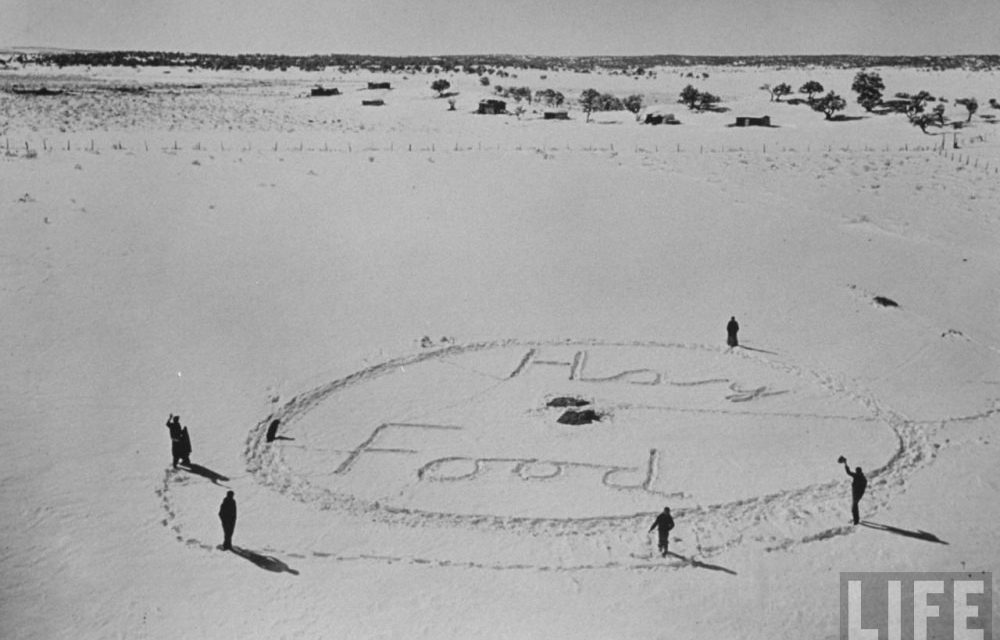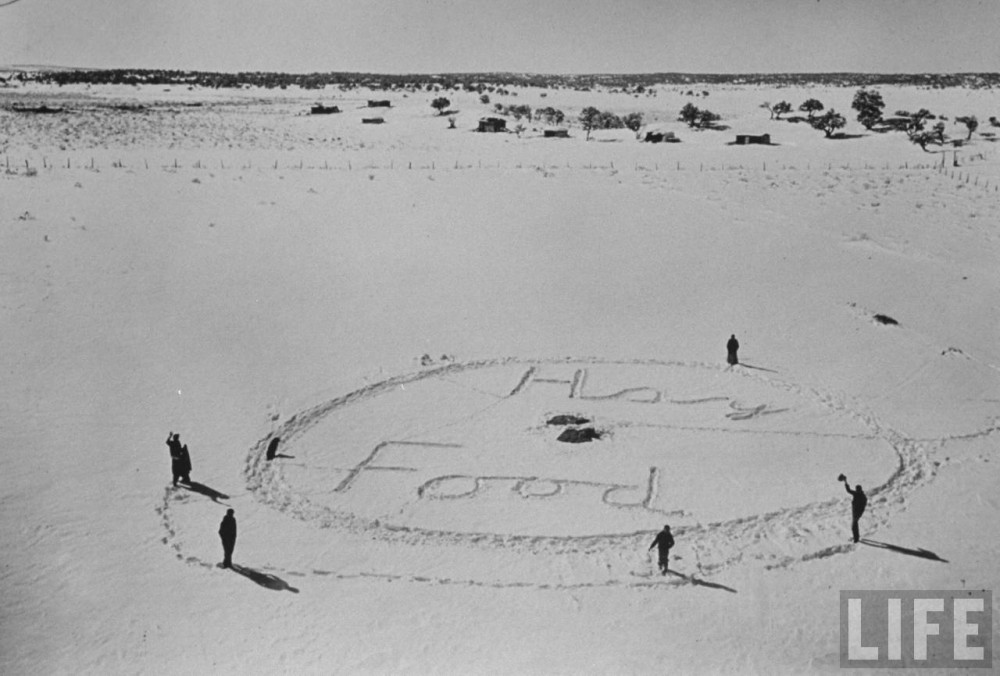
50 years ago: Emergency crews scramble as major snowstorm hits rez

Navajo shepherds hard hit by snow storm stamped out a sign requesting food & hay in 1967. (Ralph Crane, Life magazine.)

Navajo shepherds hard hit by snow storm stamped out a sign requesting food & hay in 1967. (Ralph Crane, Life magazine.)
Old-timers on the Navajo Reservation, when asked about what they remember about 1967, will probably say the snowstorms. Snow began falling on the reservation about Dec. 10 and for the next few weeks that is all people could talk about as the snows lingered, trapping thousands of Navajo families in their homes because of road conditions.
The Navajo Times, as well as newspapers throughout the Southwest, began reporting about the plight of 200 Navajos who had gone piñon picking about 40 miles north of the Piñon Chapter House and became stranded despite efforts by the Navajo Police and emergency crews to find them and get them out.
Al Adams, a superintendent for the Navajo Police Department, told reporters that the group was trapped in the middle of a piñon forest with no shelter available except for a couple of campers carried on pickups. By Dec. 14, newspapers were reporting that several Navajos had already died in the storm and Navajo officials were expecting that the number would continue to rise as the storm continued. Even the Associated Press was reporting the deaths although Adams, who would know about any deaths, said these were just rumors and so far unverified. He added that he thought the rumors started when newspapers began reporting about the stranded piñon pickers and the conditions they were being forced to endure. “We have received no reliable reports from anyone that any of the piñon pickers have died,” Adams said, adding that since they were not able to communicate with anyone, there was no way for anyone to now if anyone died.
On Dec. 14, tribal officials were saying they were receiving reports from chapters that the snow in their areas was 24 to 36 inches high. Kayenta was reporting 30 inches and added that travel was impossible so families were being told to stay in their homes. Other chapters were giving similar reports with some saying that families were ignoring their pleas to stay home and were trying to get to border communities because their food supplies were running out. Ranchers were also reporting finding some of their livestock dead in the field because it was impossible for them to dig deep enough in the snow to find something to eat.
There were only a few graders on the reservation and these had been called into service to plow the roads but Adams said in some areas the graders had to back off several yards and take a run to get through the snow. By Dec. 15, Adams was beginning to worry that the people sent to rescue the piñon pickers may be in trouble. He said Capt. Emerson Goldtooth, who was leading the rescue party, had not been heard from for more than a day and no one knew where they were.
By Dec. 16, help was coming from outside the reservation. Two helicopters had been sent from Kirtland Air Force Base and they began dropping off bundles of food to families stranded by the snowstorm. Working out of the Window Rock airstrip, they first started dropping bundles in that area to families who put signs on their roofs saying they were stranded and in need of food. By then, reports had been confirmed that at least two people, including a two-year-old boy and a disabled sheepherder, had died in the storms. The boy lived in a hogan at Big Arrows, seven miles north of U.S. Highway 66 and 35 miles west of Gallup.
But the worst was not over as tribal officials reported hearing of another major snowstorm expected to hit the reservation the night of Dec. 16, further complicating efforts to rescue the piñon pickers and the rescue squad that was sent to save them. One of the helicopters that afternoon was sent to Chinle, where reports were coming in of 24 people, mostly children, being stranded in snow two feet deep in their hogans and unable to get to the nearby Wood Spring Trading Post.
When the helicopter got to the area, the adults in the group were able to attract the attention of the crew by waving blankets as it passed overhead. Because of reports of dying sheep and cattle, the tribe secured the services of eight C119 “Flying Boxcars” out of Winslow. But after they were loaded with hay and preparing to take off, the flights had to be canceled because of the new snowstorm coming in. Requests were made to have the helicopters start dropping the hay but a spokesman for the Air Force nixed the idea. “The first thing we are going to worry about,” he said, “is the people.”
So as night settled over the reservation on Dec. 16, the situation looked grave to tribal officials and members of the Navajo Police Department.
To read the full article, pick up your copy of the Navajo Times at your nearest newsstand Thursday mornings!
Are you a digital subscriber? Read the most recent three weeks of stories by logging in to your online account.








 Highway 264,
Highway 264, I-40, WB @ Winslow
I-40, WB @ Winslow